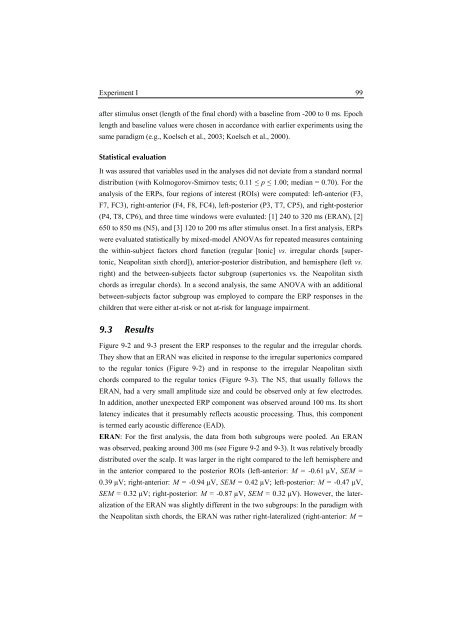Neural Correlates of Processing Syntax in Music and ... - PubMan
Neural Correlates of Processing Syntax in Music and ... - PubMan
Neural Correlates of Processing Syntax in Music and ... - PubMan
You also want an ePaper? Increase the reach of your titles
YUMPU automatically turns print PDFs into web optimized ePapers that Google loves.
Experiment I 99<br />
after stimulus onset (length <strong>of</strong> the f<strong>in</strong>al chord) with a basel<strong>in</strong>e from -200 to 0 ms. Epoch<br />
length <strong>and</strong> basel<strong>in</strong>e values were chosen <strong>in</strong> accordance with earlier experiments us<strong>in</strong>g the<br />
same paradigm (e.g., Koelsch et al., 2003; Koelsch et al., 2000).<br />
Statistical evaluation<br />
It was assured that variables used <strong>in</strong> the analyses did not deviate from a st<strong>and</strong>ard normal<br />
distribution (with Kolmogorov-Smirnov tests; 0.11 ��p ��������������������������������<br />
analysis <strong>of</strong> the ERPs, four regions <strong>of</strong> <strong>in</strong>terest (ROIs) were computed: left-anterior (F3,<br />
F7, FC3), right-anterior (F4, F8, FC4), left-posterior (P3, T7, CP5), <strong>and</strong> right-posterior<br />
(P4, T8, CP6), <strong>and</strong> three time w<strong>in</strong>dows were evaluated: [1] 240 to 320 ms (ERAN), [2]<br />
650 to 850 ms (N5), <strong>and</strong> [3] 120 to 200 ms after stimulus onset. In a first analysis, ERPs<br />
were evaluated statistically by mixed-model ANOVAs for repeated measures conta<strong>in</strong><strong>in</strong>g<br />
the with<strong>in</strong>-subject factors chord function (regular [tonic] vs. irregular chords [supertonic,<br />
Neapolitan sixth chord]), anterior-posterior distribution, <strong>and</strong> hemisphere (left vs.<br />
right) <strong>and</strong> the between-subjects factor subgroup (supertonics vs. the Neapolitan sixth<br />
chords as irregular chords). In a second analysis, the same ANOVA with an additional<br />
between-subjects factor subgroup was employed to compare the ERP responses <strong>in</strong> the<br />
children that were either at-risk or not at-risk for language impairment.<br />
9.3 Results<br />
Figure 9-2 <strong>and</strong> 9-3 present the ERP responses to the regular <strong>and</strong> the irregular chords.<br />
They show that an ERAN was elicited <strong>in</strong> response to the irregular supertonics compared<br />
to the regular tonics (Figure 9-2) <strong>and</strong> <strong>in</strong> response to the irregular Neapolitan sixth<br />
chords compared to the regular tonics (Figure 9-3). The N5, that usually follows the<br />
ERAN, had a very small amplitude size <strong>and</strong> could be observed only at few electrodes.<br />
In addition, another unexpected ERP component was observed around 100 ms. Its short<br />
latency <strong>in</strong>dicates that it presumably reflects acoustic process<strong>in</strong>g. Thus, this component<br />
is termed early acoustic difference (EAD).<br />
ERAN: For the first analysis, the data from both subgroups were pooled. An ERAN<br />
was observed, peak<strong>in</strong>g around 300 ms (see Figure 9-2 <strong>and</strong> 9-3). It was relatively broadly<br />
distributed over the scalp. It was larger <strong>in</strong> the right compared to the left hemisphere <strong>and</strong><br />
<strong>in</strong> the anterior compared to the posterior ROIs (left-anterior: M = -0.61 μV, SEM =<br />
0.39 μV; right-anterior: M = -0.94 μV, SEM = 0.42 μV; left-posterior: M = -0.47 μV,<br />
SEM = 0.32 μV; right-posterior: M = -0.87 μV, SEM = 0.32 μV). However, the lateralization<br />
<strong>of</strong> the ERAN was slightly different <strong>in</strong> the two subgroups: In the paradigm with<br />
the Neapolitan sixth chords, the ERAN was rather right-lateralized (right-anterior: M =












